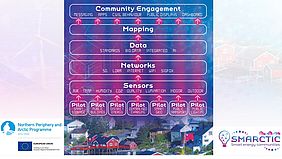The SMARCTIC project partners have completed the development of the SMART Energy Management Model (SEMM) for Northern Periphery and Arctic (NPA) regions. This model is a key project output and has inspired the approach to pilot implementation that has been adopted in each of the project regions.
The SMARCTIC project aims to empower SMART Energy Communities and SMART Regions. The SEMM will lay the foundations for these activities. The model is envisaged to act as an integrated energy communications channel between the public authority – responsible for decreasing overall energy usage in their community – and the energy consumers (homes, businesses, public infrastructure). The model will enable communication between energy stakeholders, build awareness, trial new solutions and change energy behaviour.
Conceptual Model
The partnership set out to design an initial conceptual SEMM that was adaptable for deployment in small NPA communities. The model had to be capable of integrating multiple energy efficiency pilots; collecting, analysing (using AI) and communicating real-time energy-related data from multiple sources including domestic & public buildings and infrastructure.
Technologies, Tools & Data
During the development of the model, the partnership conducted an assessment of potential technologies, data and tools capable of being integrated into the model. All of them were examined to establish if they possessed the necessary criteria to contribute to NPA SMART energy solutions, addressing specific aspects including remoteness, accessibility and climatic conditions.
Use Cases
Each region defined a concrete use case where the model could be applied following an open innovation approach involving the main stakeholders and target users. A main goal of the project was to follow a SMART City approach, but to apply this in a completely different context. This meant that the use cases were a key input when defining the model as it had to be adaptable for application into small & remote communities, and under specific climate conditions.
Final SEMM
The final SEMM defined a modular approach that orchestrated existing ICT solutions, tools and data with other new developments based on the Internet of Things (IoT), Artificial Intelligence (AI) technologies and visualization tools. This model expresses the phases of data flow, addressing data collection, analysis and output of results. These modules include networks, sensors, data, mapping and community engagement. The model will be applied in the developed solutions that give response to the various use cases identified by the partner organisations.
The SEMM will be tested in the coming period via pilots that will be deployed, monitored and analysed in various locations including, Ireland, Finland, Sweden, Iceland and the UK. The role of these deployments is to evaluate the SEMM’s effectiveness in real-life NPA conditions. The SEMM-based solutions will be monitored and assessed under a common transnational methodology to produce quantitative and qualitative information to analyse the performance of the solutions developed. This analytical information will also be used to continuously upgrade and improve the SEMM.
The full SMART Energy Management Model (SEMM) and accompanying report will be available in August on the SMARCTIC Website.

